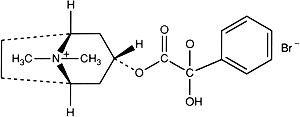Monographs: Pharmaceutical substances: Homatropine methylbromide (Homatropini methylbromidum)

C17H24BrNO3
Relative molecular mass. 370.3
Chemical name. 3α-Hydroxy-8-methyl-1αH,5αH-tropanium bromide (±)-mandelate;(±)-endo-3-[(hydroxyphenylacetyl)oxy]-8,8-dimethyl-8-azoniabicyclo-[3.2.1]octane bromide; CAS Reg. No. 80-49-9.
Description. A white, crystalline powder; odourless.
Solubility. Very soluble in water; freely soluble in ethanol (~750 g/l) TS; practically insoluble in ether R and acetone R.
Category. Mydriatic.
Storage. Homatropine methylbromide should be kept in a tightly closed container, protected from light.
Additional information. Homatropine methylbromide darkens on exposure to light.
Requirements
Homatropine methylbromide contains not less than 98.5% and not more than the equivalent of 101.0% of C17H24BrNO3, calculated with reference to the dried substance.
Identity tests
A. Dissolve 10 mg in 1 mL of water, add ammonia (~100 g/l) TS to render the solution slightly alkaline, and shake with 5 mL of chloroform R. Evaporate the chloroform layer to dryness on a water-bath and add 1.5 mL of mercuric chloride/ethanol TS to the residue; no yellow or red colour is produced (distinction from homatropine, atropine, and other solanaceous alkaloids).
B. A 20 mg/mL solution yields reaction A described under 2.1 General identification tests as characteristic of bromides.
C. Melting temperature, about 190 °C.
Sulfated ash. Not more than 2.0 mg/g.
Loss on drying. Dry to constant mass at 105 °C; it loses not more than 10 mg/g.
pH value. pH of a 10 mg/mL solution, 4.5-6.5.
Related substances. Carry out the test as described under 1.14.1 Chromatography, Thin-layer chromatography, using silica gel R5 as the coating substance and a mixture of 6 volumes of 1-propanol R, 3 volumes of water, 2 volumes of methanol R, and 1 volume of glacial acetic acid R as the mobile phase. Apply separately to the plate 5 μl of each of two solutions in a mixture of 9 volumes of methanol R and 1 volume of water containing (A) 40 mg of Homatropine methylbromide per mL and (B) 0.4 mg of Homatropine methylbromide per mL. After removing the plate from the chromatographic chamber, allow it to dry in air, spray it first with potassium iodobismuthate TS2 and then with sodium nitrite (50 g/l) TS. Examine the chromatogram in daylight.
Any spot obtained with solution A, other than the principal spot, is not more intense than that obtained with solution B.
Assay. Dissolve 0.300 g in 10 mL of water R. Carry out a potentiometric titration using silver nitrate (0.1 mol/L) VS and a silver indicator electrode and a silver-silver chloride reference electrode.
1 mL of silver nitrate (0.1 mol/L) is equivalent to 37.03 mg of C17H24BrNO3.